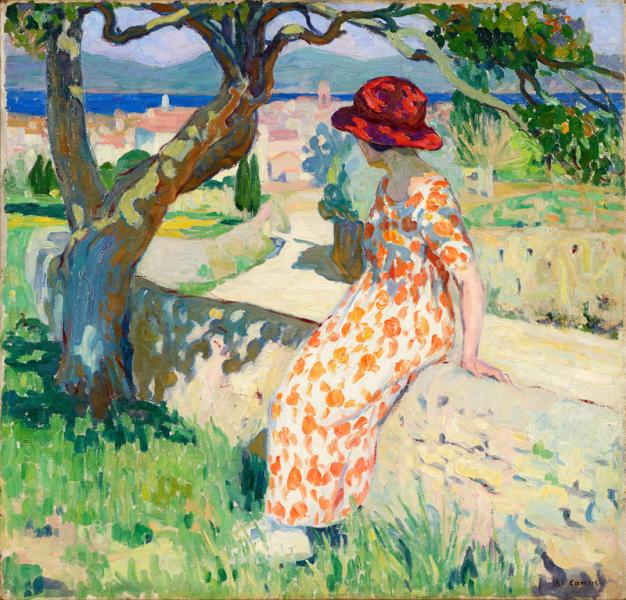Jeune fille devant Saint-Tropez
Oil on canvas, signed lower right.
71 x 74 cm
Provenance :
Private collection, France
DO YOU SAINT-TROPEZ?
This is the only painting by a woman that we are able to present at this exhibition. Women on canvas, seen by men, yes, but women with brushes, women behind the controls, very few!
In recent years, this absence has become politically apparent. With a series of high-profile exhibitions, attempts are being made to repair the omissions, to plug the gaps in the non-existence of women in the history of art that precedes the contemporary period.
The women who braved so many obstacles to exist as artists, who dared to look elsewhere to create something other than the floral watercolors or miniatures traditionally assigned to them (delicate work for their fragile hands), are to be swooned over. Rosa Bonheur, Berthe Morisot, Camille Claudel and Suzanne Valadon. Each in turn is sanctified. But as there aren't many of them, once the most talented have been beatified, we exhume all the others, hoping at all costs to redeem ourselves: it won't be said that the man of the 21st century will be the Gargantua of the previous era. The most timid are pushed into the limelight, flaunted and made fashionable.
The woman artist becomes a standard-bearer. However, not all artists are equal, and the mere fact of being a woman who has wielded a paintbrush does not justify privileged treatment.
What women want is not mercy, nor indulgence, nor charity towards their forebears. What women want is to be able to learn and work without discrimination. Equal merit, equal opportunity. Equal talent, equal reward.
That's what they've been missing out on. In essence, it's impossible to make up for the past, despite the best will in the world. The only thing that counts is our commitment to try to do better in the future.
Blanche Camus was born in Paris in 1884 to a pharmacist-botanist father. She attended the Académie Julian, a renowned free art academy with a strong emphasis on drawing, which was also open to women (provided they paid twice the tuition for men).
With the difference that the male model wears boxer shorts during posing sessions, they can even work with "nude" models, both male and female, in a class reserved for them.
Blanche then enrolled at the Ecole des Beaux-Arts, where she was a student from 1902 to 1908. Women had only been admitted to the school for a few years, and it was not until 1903, during the course of her studies, that they were finally allowed to compete for the prestigious Prix de Rome, the public crowning of a vocation and the launch of a career for the lucky winner.
In 1908, Blanche Camus moved to Saint-Tropez. It was in the Mediterranean light that she drew most of her inspiration. Like this painting, she often portrayed women in sunny landscapes, everyday scenes or family scenes, in a gentle southern way of life.
These subjects, their execution and their light-filled treatment, are reminiscent of the works of Henri Lebasque, who enjoyed greater success.
In 1915, with her sister Aimée-Antoinette, a renowned botanist, she set off on a journey through the Pyrenees, venturing almost as far as Turkey along the shores of the Mediterranean.
That's about all that's survived of the artist's life. Fortunately, his work has not been completely forgotten, as some of his paintings can be found in French museums (in Besançon, Châlon-sur-Saône, Douai, Lyon and Nice), and the artist produced enough for the market to occasionally see a good canvas like the one presented here.
In the shade of a tree, a young woman elegantly leans against the low wall bordering a path, her face turned towards a distance that the viewer of the painting is also contemplating.
At the end of the path, a little lower down, Saint-Tropez spreads out its pink roofs, dominated by its Mediterranean campanile. In the background, the sea and the bluish mountains close in on the horizon.
The whole is skilfully studied and layered. The same is true of the colors, as the orange-red feminine universe emerges in this green setting. Enhanced by the treatment of light, this piece of spring is a success.

